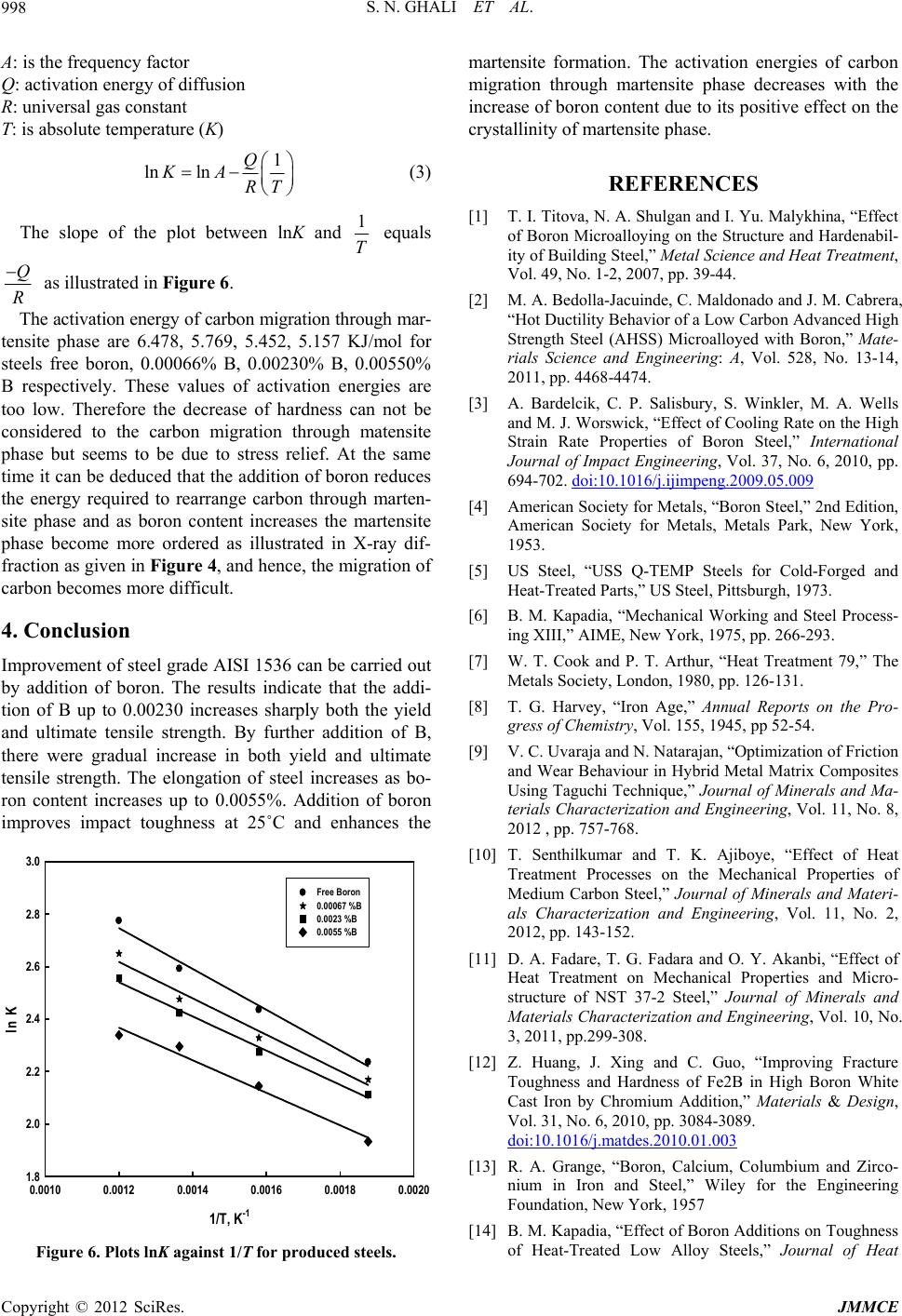
S. N. GHALI ET AL.
998
A: is the frequency factor
Q: activation energy of diffusion
R: universal gas constant
T: is absolute temperature (K)
1Q
RT
(3)
The slope of the plot betwnK and
ln ln
KA
een l1
T equals
Q as illustrated in Figure 6.
he activation energy of carbo
R
Tn migration through mar-
tensi
eel grade AISI 1536 can be carried out
te phase are 6.478, 5.769, 5.452, 5.157 KJ/mol for
steels free boron, 0.00066% B, 0.00230% B, 0.00550%
B respectively. These values of activation energies are
too low. Therefore the decrease of hardness can not be
considered to the carbon migration through matensite
phase but seems to be due to stress relief. At the same
time it can be deduced that the addition of boron reduces
the energy required to rearrange carbon through marten-
site phase and as boron content increases the martensite
phase become more ordered as illustrated in X-ray dif-
fraction as given in Figure 4, and hence, the migration of
carbon becomes more difficult.
4. Conclusion
Improvement of st
by addition of boron. The results indicate that the addi-
tion of B up to 0.00230 increases sharply both the yield
and ultimate tensile strength. By further addition of B,
there were gradual increase in both yield and ultimate
tensile strength. The elongation of steel increases as bo-
ron content increases up to 0.0055%. Addition of boron
improves impact toughness at 25˚C and enhances the
1/T, K
-1
0.0010 0.0012 0.0014 0.0016 0.0018 0.0020
ln K
1.8
2.0
2.2
2.4
2.6
2.8
3.0
Free Boron
0.00067 %B
0.0023 %B
0.0055 %B
Figure 6. Plots lnK against 1/T for produced steels.
martensite formation. The activation energies of carbon
migration through martensite phase decreases with the
increase of boron content due to its positive effect on the
crystallinity of martensite phase.
REFERENCES
[1] T. I. Titova, N. A. Shulgan and I. Yu. Malykhina, “Effect
of Boron Microalloying on the Structure and Hardenabil-
ity of Building Steel,” Metal Science and Heat Treatment,
Vol. 49, No. 1-2, 2007, pp. 39-44.
[2] M. A. Bedolla-Jacuinde, C. Maldonado and J. M. Cabrera,
“Hot Ductility Behavior of a Low Carbon Advanced High
Strength Steel (AHSS) Microalloyed with Boron,” Mate-
rials Science and Engineering: A, Vol. 528, No. 13-14,
2011, pp. 4468-4474.
[3] A. Bardelcik, C. P. Salisbury, S. Winkler, M. A. Wells
and M. J. Worswick, “Effect of Cooling Rate on the High
nal
Strain Rate Properties of Boron Steel,” Internatio
Journal of Impact Engineering, Vol. 37, No. 6, 2010, pp.
694-702. doi:10.1016/j.ijimpeng.2009.05.009
[4] American Society for Metals, “Boron Steel,” 2nd Edition,
American Society for Metals, Metals Park, New York,
1953.
[5] US Steel, “USS Q-TEMP Steels for Cold-Forged and
Heat-Treated Pgh, 1973.
126-131.
que,” Journal of Minerals and Ma-
nd Materi-
dare, T. G. Fadara and O. Y. Akanbi, “Effect of
ls and
arts,” US Steel, Pittsbur
[6] B. M. Kapadia, “Mechanical Working and Steel Process-
ing XIII,” AIME, New York, 1975, pp. 266-293.
[7] W. T. Cook and P. T. Arthur, “Heat Treatment 79,” The
Metals Society, London, 1980, pp.
[8] T. G. Harvey, “Iron Age,” Annual Reports on the Pro-
gress of Chemistry, Vol. 155, 1945, pp 52-54.
[9] V. C. Uvaraja and N. Natarajan, “Optimization of Friction
and Wear Behaviour in Hybrid Metal Matrix Composites
Using Taguchi Techni
terials Characterization and Engineering, Vol. 11, No. 8,
2012 , pp. 757-768.
[10] T. Senthilkumar and T. K. Ajiboye, “Effect of Heat
Treatment Processes on the Mechanical Properties of
Medium Carbon Steel,” Journal of Minerals a
als Characterization and Engineering, Vol. 11, No. 2,
2012, pp. 143-152.
[11] D. A. Fa
Heat Treatment on Mechanical Properties and Micro-
structure of NST 37-2 Steel,” Journal of Minera
Materials Characterization and Engineering, Vol. 10, No.
3, 2011, pp.299-308.
[12] Z. Huang, J. Xing and C. Guo, “Improving Fracture
Toughness and Hardness of Fe2B in High Boron White
Cast Iron by Chromium Addition,” Materials & Design,
Vol. 31, No. 6, 2010, pp. 3084-3089.
doi:10.1016/j.matdes.2010.01.003
[13] R. A. Grange, “Boron, Calcium, Columbium and Zirco-
nium in Iron and Steel,” Wiley for the Engineering
Foundation, New York, 1957
[14] B. M. Kapadia, “Effect of Boron Additions on Toughness
of Heat-Treated Low Alloy Steels,” Journal of Heat
Copyright © 2012 SciRes. JMMCE